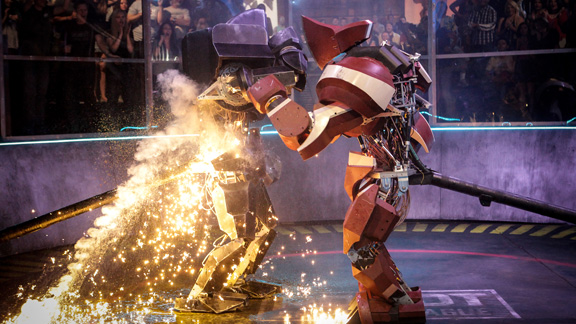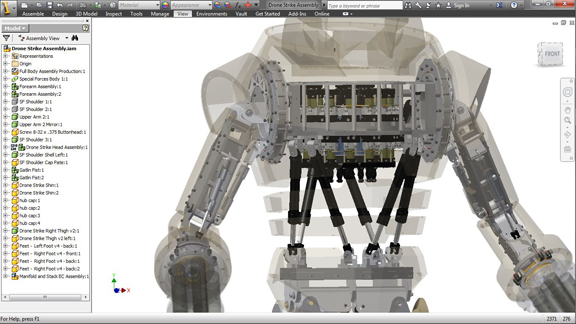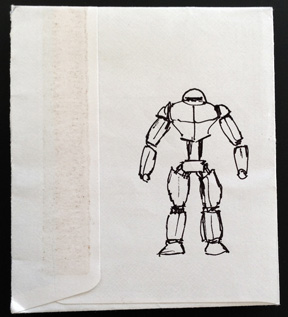Latest News
April 9, 2013
This is a new kind of hand-to-hand combat. Here, size doesn’t matter. In this arena, a geeky software engineer has just as much a chance of landing a crippling blow as a hurdle-jumping Olympian, and a video game player can be just as lethal as a National Guard veteran or a professional Muay Thai fighter. Welcome to Robot Combat League (RCL), SyFy’s new reality TV show, where human opponents battle each other through mechanical avatars.
Mark Setrakian, whose puppetry was behind the menacing monsters in Lady in the Water, Hellboy, and Men in Black II and III, designed and created RCL’s robotic gladiators. With names like Brimstone, Medieval, Drone Strike, and Thunder Skull, the oversize mechanical warriors are characters in their own rights, endowed with their own personalities, vulnerabilities, and advantages. On fight night, human opponents slip into the exo-suits to remotely command their metallic fighters. As the contestants swing and strike, the 8-ft, 1,000-LB robots engage each other in a showdown. Often, the deadliest blows are the gut-punches. This happens when one robot manages to tear through the hydraulic pipes connecting its opponent’s legs and torso, gushing fire and fluid everywhere.
RCL’s similarity to Real Steel, a sci-fi featuring futuristic boxing matches with human-controlled robots, isn’t lost on Setrakian. In a way, it made his job easier when pitching the idea. All he had to say was, “It’s kind of like Real Steel.” Setrakian’s background is in entertainment; his specialty is animatronic creatures and monsters. He developed a taste for the thrill of fighting robots after becoming involved in Battle Bots and Robot Wars.
The RCL robots usually begin as Setrakian’s hand-drawn sketches (in some cases, they were literally drawn on the back of an envelope). He uses Autodesk Inventor to add shape, surface, volume, and geometry to refine his ideas in 3D. “I appreciate being able to build extremely detailed models,” he said. “It’s important for me to know ahead of times that all the pieces are going to fit, that they won’t be crashing anywhere. The stuff I’m working on has lots of moving parts, lots of freedom. It’s important for me to know that the arm shell isn’t going to crash into the chest piece.”
To study combat movements, Setrakian even went boxing himself. That was how he found out the twist along the waist was crucial to delivering powerful punches. The discovery led to the robot’s standard waist configuration: a network of flexible hydraulic cables joining the upper half to the bottom.
Setrakian currently uses Autodesk Inventor only to design and visualize the robots’ shapes and movements. He hasn’t delved into software-based stress analysis and more advanced simulation, but that may be on the horizon. “Simulation is very important. That’s my next step,” said Setrakian. “You’d be amazed at what would break. Sometimes I say, Wow, I didn’t think that could happen!” In at least two matches, one robot managed to cut its opponent into halves—something Setrakian didn’t anticipate.
Setrakian estimates the cost of a full-size fighting robot to be around $200,000, prohibitive enough even for the lucrative TV industry. So he has to be judicious about when to deploy the actual robot, and when to risk damage. Working on RCL, he confronts the same issues automotive and aerospace manufacturers face daily. “It’s kind of like cars, where the dynamics of how they’re destroyed have to be carefully thought out,” he noted. Like automakers who conduct crash tests, he too has to anticipate how his robots might fail. In his case, “Getting destroyed is part of the robot’s lifecycle,” he pointed out. He experiments with different materials, so he can get the optimal breaking behavior, something that looks good on screen and also keeps the robot alive long enough for an exciting match.
Because the robot’s skin (the outer shell) is typically made of sheet metal pieces, Setrakian relies on Autodesk Inventor’s sheet-metal tools to create them. “I usually make a shape, then turn it into a surface model. The ability to grow the surface model from both sides of the plane—That’s important. That’s how my CAM (computer-aided manufacturing) software operates,” he added.
Unlike typical game controllers (a joystick or an Xbox controller, for example), the exo-suit allows the robot driver to use natural gestures like swings and hooks during the fight. The exo-suit and the robot’s movements are synchronized remotely. Setrakian’s strives to keep the time delay down to 50 millisecond. “It’s just transferring the movements in the exo-suit to the robot, so there isn’t a lot of computation going on,” he said. But physics sometimes gets in the way. The robot has fists that weigh roughly 25 LBs each. It needs more time and energy than its human controller to execute combat maneuvers.
Finding the right balance between the robot’s size and speed and its human driver’s natural agility is Setrakian’s biggest challenge. For season 2, he plans to further explore that sweet spot. He might even let contestants provide input on how to customize their metallic fighters. You can watch full episodes of RCL at SyFy’s official site.
For more, watch the trailer of Robot Combat League below.
Subscribe to our FREE magazine, FREE email newsletters or both!
Latest News
About the Author
Kenneth Wong is Digital Engineering’s resident blogger and senior editor. Email him at [email protected] or share your thoughts on this article at digitaleng.news/facebook.
Follow DE








